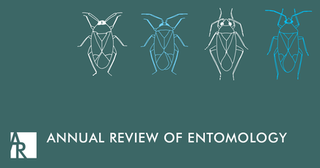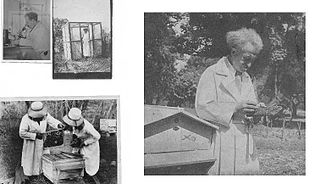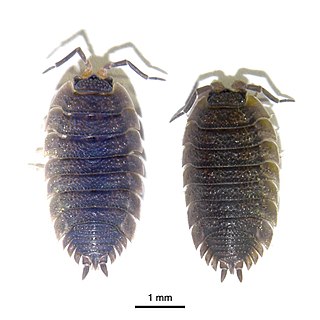
A larva is a distinct juvenile form many animals undergo before metamorphosis into adults. Animals with indirect development such as insects, amphibians, or cnidarians typically have a larval phase of their life cycle.

Entomology is the scientific study of insects, a branch of zoology. In the past the term "insect" was less specific, and historically the definition of entomology would also include the study of animals in other arthropod groups, such as arachnids, myriapods, and crustaceans. This wider meaning may still be encountered in informal use.

Plant pathology is the scientific study of diseases in plants caused by pathogens and environmental conditions. Organisms that cause infectious disease include fungi, oomycetes, bacteria, viruses, viroids, virus-like organisms, phytoplasmas, protozoa, nematodes and parasitic plants. Not included are ectoparasites like insects, mites, vertebrate, or other pests that affect plant health by eating plant tissues. Plant pathology also involves the study of pathogen identification, disease etiology, disease cycles, economic impact, plant disease epidemiology, plant disease resistance, how plant diseases affect humans and animals, pathosystem genetics, and management of plant diseases.

Hemiptera is an order of insects, commonly called true bugs, comprising over 80,000 species within groups such as the cicadas, aphids, planthoppers, leafhoppers, assassin bugs, bed bugs, and shield bugs. They range in size from 1 mm (0.04 in) to around 15 cm (6 in), and share a common arrangement of piercing-sucking mouthparts. The name "true bugs" is often limited to the suborder Heteroptera.

Mites are small arachnids. Mites span two large orders of arachnids, the Acariformes and the Parasitiformes, which were historically grouped together in the subclass Acari. However, most recent genetic analyses do not recover the two as each others closest relatives within Arachnida, rendering the group non-monophyletic. Most mites are tiny, less than 1 mm (0.04 in) in length, and have a simple, unsegmented body plan. The small size of most species makes them easily overlooked; some species live in water, many live in soil as decomposers, others live on plants, sometimes creating galls, while others again are predators or parasites. This last type includes the commercially destructive Varroa parasite of honey bees, as well as scabies mites of humans. Most species are harmless to humans, but a few are associated with allergies or may transmit diseases.

Beauveria bassiana is a fungus that grows naturally in soils throughout the world and acts as a parasite on various arthropod species, causing white muscardine disease; it thus belongs to the entomopathogenic fungi. It is used as a biological insecticide to control a number of pests, including termites, thrips, whiteflies, aphids and various beetles. Its use in the control of bedbugs and malaria-transmitting mosquitos is under investigation.

Phomopsis cane and leaf spot occurs wherever grapes are grown. Phomopsis cane and leaf spot is more severe in grape-growing regions characterized by a humid temperate climate through the growing season. Crop losses up to 30% have been reported to be caused by Phomopsis cane and leaf spot.
Raymond J. St. Leger is an American mycologist, entomologist, molecular biologist and biotechnologist who currently holds the rank of Distinguished University Professor in the Department of Entomology at the University of Maryland, College Park.

The Annual Review of Entomology is a peer-reviewed academic journal that publishes review articles about entomology, the study of insects. First published in 1956 from a collaboration between the Entomological Society of America and Annual Reviews, its longest-serving editors are Thomas E. Mittler (1967–1997) and May Berenbaum (1998–2018). As of 2022, it has a 2021 impact factor of 22.682.

Nudiviruses are a family of animal viruses that constitute the family Nudiviridae. Insects and marine crustaceans serve as natural hosts. There are 11 species in this family, assigned to 4 genera. Diseases associated with this family include: death in larvae, chronic disease in adults.

André Paillot was a French entomologist known for his pioneering work on the pathology of insects. His contributions and achievements had a significant influence on the studies of insect diseases.
Forest pathology is the research of both biotic and abiotic maladies affecting the health of a forest ecosystem, primarily fungal pathogens and their insect vectors. It is a subfield of forestry and plant pathology.

Antheraea paphia, known as the South India small tussore, the tasar silkworm and vanya silkworm is a species of moth of the family Saturniidae found in India and Sri Lanka. The bulk of the literature on this species uses a junior synonym, Antheraea mylitta, rather than the correct name, A. paphia. It is one of a number of tasar silkworms, species that produce Tussar silk, a kind of wild silk that is made from the products of saturniid silkworms instead of the domesticated silkworm.
Hayk Mirzayans was an Iranian Armenian entomologist.
Ann E. Hajek is an American entomologist with a focus in insect-microbe interactions. She is a Professor of Entomology at Cornell University.
Edward Arthur Steinhaus was an American bacteriologist and pathologist who specialized in insect pathology particularly on the applications of microorganisms for the control of insect pests. He also served as the founder or cofounder of the Annual Review of Entomology, the Journal of Invertebrate Pathology, and the Society for Invertebrate Pathology.

Betairidovirinae is a subfamily of viruses in the family Iridoviridae that was established in 2016. It is one of two subfamilies within this family, the other being Alphairdovirinae. Most species within the Betairidovirinae are hosted by invertebrates, whereas all species within the Alphairdovirinae are hosted by 'cold-blooded' vertebrates. As such, viruses in this subfamily may be called invertebrate iridescent viruses (IIVs) or invertebrate iridoviruses.
Donald W. Roberts was an insect pathologist and one of the originators of that field. He was especially known for research into biological pest control of Lepidoptera by Metarhizium but also Beauveria bassiana. He was a Research Professor Emeritus in the Biology Department of Utah State University.
Anopheles arabiensis is a zoophilic species of mosquito and a vector of disease endemic to Africa.











